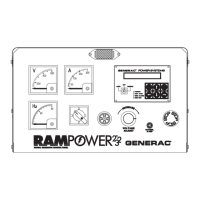Generac
®
Power Systems, Inc. 21
2. If either test 1 or 2 failed:
2.1 Repeat the open and short circuit testing
directly at the back of the E Panel as follows:
Open: The 69 wire should be removed from
CON2-5
Short: With the 69 wire still removed, insert
a jumper wire into CON2-5. Connect
the other end of the jumper to ground
(0).
After testing, remove the jumper wire from
CON2-5 and insert the 69 wire back into
CON2-5
2.2 Test results:
2.2.1 If these tests fail again directly at the
back of the E Panel, then the E Panel
has failed and should be replaced.
2.2.2 If these tests pass at the back of the E
Panel, but failed at the terminal strip,
then there is a wiring error between the
E Panel and the terminal strip. Check
this wiring carefully.
TESTING THE OIL PRESSURE SENDER
The resistance of the OPS can be checked in a power
down state as follows:
1. Remove the control panel fuse to power down the
E panel.
2. Unplug CON2 from the E Panel.
3. Measure the resistance of the oil pressure sender.
This measurement should be made between the
sender terminal and the sender body.
The sender resistance should measure between 225
and 260 Ohms at 0 PSI.
NOTE:
If the engine has just been stopped, allow suffi-
cient time for the oil pressure to drop to zero
before making this measurement.
If the resistance measurement is not in this range, the
sender has failed. Replace the sender.
If the resistance measurement is in this range, move
on to the next test.
TESTING THE OIL PRESSURE SENDER
CONNECTIONS
Visual Inspection
Carefully check the wiring between the oil pressure
sender and the E Panel.
1. Check the 69 wire connection to the OPS.
1.1 Check for a proper crimp on the lug.
1.2 Check to see if the sender nut is tightened
securely. Be careful not to over tighten the
nut. If the nut is over tightened, the stud will
break free and cause incorrect sender read-
ings. This nut should be tightened to 14 to 18
inch pounds.
1.3 Check for any environmental corrosion on
the lug or the sender terminal. Generac rec-
ommends the following actions if corrosion is
found:
1.3.1 Replace the lug.
1.3.2 Replace the sender if possible. If not
possible, thoroughly remove all of the
corrosion from the sender terminal.
1.3.3 Protect the lug and sender terminal
with an approved automotive dielectric
grease.
2. Check the 69 wire in the Deutsch connector (only
used on the "water tight connector" panels.)
2.1 Refer to appendix A for information on the
Deutsch connectors used.
2.2 Refer to the unit's wire diagram for the 69
location in the Deutsch plug.
3. Check the 69 wire on the control panel terminal
strip.
3.1 Check for a proper crimp on both lugs.
3.2 Check to see if both screws are tightened
securely. These screws should be tightened to
12 inch pounds.
4. Check the 69 wire going into CON2 on the back of
the E Panel.
4.1 Check to see if the wire is stripped properly
inside the green plug. The wire conductor
should be trapped inside the metal wire
clamp. The wire insulation should not be
trapped inside the metal wire clamp.
4.2 Check to see if the set screw is tightened
securely, but do not over tighten. This screw
should be set to 2 to 4 inch pounds.
5. Check for any wire damage along the entire run
between the E Panel and the sender.
5.1 Check for any areas along the wire with miss-
ing insulation. This could allow the 69 line to
momentarily come into contact with ground
causing a false shut down.
5.2 Check to see if the wire is pinched anywhere
along the run. A wire that is pinched between
the sheet metal can cause the 69 wire to
momentarily come into contact with ground
resulting in a shut down fault. A pinched wire
may also cause the wire to break inside the
insulation. This could cause the 69 line to
monetarily "open" while running. This will
also result in a shut down fault.
Section 3 — Troubleshooting and Diagnosis
E Option Control Panels

